Becoming a firefighter is like learning a new language. Many candidates think that it is easy to become a firefighter, and there is not much to learn.
Once they start taking fire technology classes at the local community college or get hired by a fire department and have to now retain and understand the masses amounts of technical information that is thrown to them, they soon understand it is not as easy as they may have perceived it to be.
If you are one of those folks that think they know it all, please think again. There are numerous terms and phrases unique to the fire service and to our industry.
Fully understanding those terms and being able to provide a personalized definition should someone ask (such as during an oral interview or during your probationary process), will help lead to your success as a firefighter.
At the bare minimum, every firefighter needs to know and understand the following words or terms, and also have a definition they can offer (that doesn't sound like it was straight out of the dictionary) to an oral board or to their probationary officers they work under.
In alphabetical order, here are some words to know and understand (to successfully become a firefighter):
- Accountability
- Adaptable
- Adverse Impact
- Aerial Device
- Aerial Ladder
- Aerial Ladder Platform
- Aggressiveness
- Alarm Assignment
- All Clear
- Anchor Point
- Area of Origin
- Arson
- Assisting Agency
- Attic Ladder
- Automatic Aid
- Automatic Sprinkler System
- Backdraft
- Backfire
- Balloon Frame Construction
- Base
- Beam
- Beam Raise
- Bed Section
- Belay
- Bight
- Boiling Point
- Booster Line/Hose
- Boundary Drop
- Bowline
- Budget
- Building Construction
- Bumper Line
- Burn Index
- Burning Out
- Capital Budget
- Caring
- Cellar Nozzle
- Central Station Alarm System
- Chain of command
- Chain Saw
- Chief Officer
- Circular Saw
- Class A Fire
- Class B Fire
- Class C Fire
- Class D Fire
- Class K Fire
- Cockloft
- Code 2
- Code 3
- Code 4
- Cold Trail
- Collapse Zone
- Combustible Liquid
- Combustion
- Command
- Command Post
- Command Staff
- Commitment
- Commitment to life-long learning and education
- Communication
- Company
- Company Officer
- Compassion
- Concrete Tilt Up Construction
- Conduction
- Confined Space
- Confinement
- Control Zones
- Convection
- Cooperating Agency
- Cornice
- Critical Incident Stress Debriefing
- Crowd Control
- Cryogenic
- Cultural Diversity
- Customer Service
- Decay Phase
- Deck Gun
- Decontaminate
- Dedication
- Defensive Mode/Strategy
- Deluge Sprinkler System
- Demobilization (or Demob)
- Dependability
- Determination
- Direct Attack
- Directive
- Discipline
- Division
- Division of Labor
- Diversity
- Dogs
- Double Female
- Double Male
- Dry Barrel Hydrant
- Duff
- Ego (or lack of)
- Egress
- Emergency Operations Center
- Emergency Traffic
- Empathy
- Employee Assistance Program
- Entitlement
- Escape Route
- Ethics
- Evacuation
- Expectations
- Exposures
- Extinguishment
- Extended Attack
- Extension Ladder
- Extrication
- Fast Attack
- Finance Section Chief
- Fire
- Fire Attack
- Fire Department Connection
- Fire Flank
- Fire Flow
- Fire Investigation
- Fire Line
- Fire Load
- Fire Mark
- Fire Prevention
- Fire Tetrahedron
- Fire Triangle
- Fire Watch
- First Due
- First Responder
- Fixed Temperature Heat Detector
- Flameover
- Flammable Liquid
- Flash Fuels
- Flashover
- Flashpoint
- Flat Head Axe
- Flat Raise
- Flexible
- Fly Section
- Fog Nozzle
- Folding Ladder
- Forward Lay
- Four-Step Teaching Method
- Four-Way Hydrant Valve
- Free Burning Phase
- Friction Loss
- Fuel
- Fuel Type
- Fusible Link
- Gang Nail
- General Staff
- Goals
- Good listener
- Grommets
- Ground Fault Circuit Interrupter
- Ground Ladder
- Group
- Gusset Plate
- Halligan
- Harassment
- Hard Suction Hose
- Hazard Assessment
- Head Pressure
- Header
- Heat Detector
- Heat Transfer
- Heel
- Helibase
- Helicopter Tender
- Helispot
- Helitack
- Helitanker
- Honesty
- Honor
- Horizontal Ventilation
- Hose Lay
- Hydraulic Ventilation
- Ignition
- Ignition Component
- Ignition Temperature
- Immediately Dangerous to Life and Health
- Incendiary Fire
- Incident Action Plan
- Incident Base
- Incident Commander
- Incident Command System
- Incipient Phase
- Increaser
- Indirect Attack
- Information Officer
- Initial Attack
- Initiative
- Inspection Hole
- Inspector's Test Valve
- Integrity
- Interior Attack
- Investigate
- Ionization Smoke Detector
- Isolate
- Kelly Day
- Kernmantle Rope
- Lapping
- Large Diameter Hose
- Lateral Transfer
- Leadership
- Leeward
- Level I Staging
- Level II Staging
- Lightweight Construction
- Load Bearing Wall
- Local Alarm System
- Liability
- Life Safety
- Line Item Budget
- Lobby Control
- Local Alarm System
- Lock Out/Tag Out
- Logistics Section Chief
- Loyalty
- Lower Explosive Limit
- Lower Flammable Limit
- Management By Objectives
- Manual Pull Station
- Maslow's Hierarchy of Needs
- Masonry
- Master Plan
- Master Stream
- Maturity
- Mayday
- Mechanical Ability
- Michigan Vs. Tyler
- Mitigate
- Mop Up
- Motivation
- Mushrooming
- Mutual Aid
- Negligence
- Organized
- Obedience
- Objectives
- Offensive Mode/Strategy
- Operational Period
- Operations Section Chief
- Outside Screw & Yoke Valve
- Overhaul
- Oxidizer
- Parallel Attack
- Parapet Wall
- Passion
- Pawls
- Performance Evaluation
- Persistence
- Perseverance
- Personal Accountability Report
- Personnel Accountability System
- Photoelectric Smoke Detector
- Pick Head Axe
- Pike Pole
- Placard
- Plan Check
- Planning Section Chief
- Plectron
- Point of Origin
- Post Incident Analysis
- Post Indicator Valve
- Preconnect
- Preaction Sprinkler System
- Pre-Fire Plan
- Primary Search
- Private Hydrant
- Progressive Discipline
- Progressive Hoselay
- Property Conversation
- Prusik
- Public Education
- Public Information Officer
- Public Safety Answering Point
- Pump and Roll
- Pump Panel
- Punctual
- Purlin
- Pyrolysis
- Quint
- Radiation
- Rapid Intervention Crew/Team
- Rate of Rise Heat Detector
- Rate of Spread
- Reasonable Accommodation
- Record Keeping
- Reducer
- Rehabilitation (or Rehab)
- Rescue
- Residual Pressure
- Resource Management
- Response Time
- Responsibility
- Reverse Lay
- Ridge
- Riser
- Risk Management
- Rollover
- Sacrifice
- Safety
- Safety Officer
- Safety Zone
- Salvage
- Scene Assessment
- Scene Management
- Scene Size-up
- Secondary Search
- Sector
- Sexual Harassment
- Shelter In Place
- Shoring
- Single Resource
- Size Up
- Smoke
- Smoke Alarm
- Smoke Detector
- Smoldering Phase
- Solid Stream / Smooth Bore Nozzle
- Span of Control
- Split Lay
- Spontaneous Combustion
- Spotting
- Staging
- Staging Area
- Standpipe
- Stang Gun
- Static Pressure
- Still Alarm
- Stop Drop and Roll
- Straight Ladder
- Strategic Plan
- Strategy
- Street Box
- Strike Team
- Stud
- Studious
- T-Card
- Tactics
- Target Hazard
- Task Force
- Teamwork
- Technical Rescue
- Tenacity
- Thermal Balance
- Thermal Imbalance
- Tiller Truck
- Tilt Up Construction
- Time Management
- Topography
- Tormentor Pole
- Tower Ladder
- Traffic Control
- Training
- Transfer of Command
- Trench Cut
- Triple Combination Pumper
- Trunked Radio System
- Truss
- Turnout Time
- Two-in, Two-out
- Type I Construction
- Type II Construction
- Type III Construction
- Type IV Construction
- Type V Construction
- Type I Engine
- Type II Engine
- Type III Engine
- Type IV Engine
- Under Control
- Unified Command
- Unity of Command
- Upper Explosive Limit
- Upper Flammable Limit
- Utilities
- Utility Rope
- Validity
- Values
- Vapor Density
- Vapor Pressure
- Ventilation
- Vertical Ventilation
- V Pattern
- Water Flow Alarm
- Water Gong
- Water Hammer
- Water Shuttle
- Water Supply
- Water Tender
- Water Thief
- Wet Barrel Hydrant
- Weather
- Windward
- Work Ethic
- Working Fire
- Wye
If any of the above items are new or foreign to you, please take the time to understand them and learn more about them. Doing so will increase your knowledge of fire science and the fire service in general, and help prove your commitment and dedication to the best career in the world. It is not uncommon to have people ask you what those above items mean, during an oral interview or during your probationary process. Don't be the one that says, "I don't know, but I'll get back to you," or the one that tries to B.S. their way through an answer because they have no clue what you are asking.
If you are planning to become a firefighter or if you already are a firefighter, you should have a personalized definition (as opposed to a standard textbook answer) and understanding of the abovementioned words, terms or phrases. You never know when you will be put on the spot and be expected to provide a definition. The choice is yours - be prepared or unprepared.
Steve Prziborowski is a Captain with the Santa Clara County (Los Gatos, CA.) Fire Department and has been in the fire service for 12 years. He is also the Fire Technology Coordinator at Chabot College in (Hayward, CA.), where he has been instructing fire technology and EMT courses for 10 years. He is a state certified Chief Officer, Fire Officer, Master Instructor, Hazardous Materials Technician, and state licensed Paramedic. He has an Associate's degree in Fire Technology, a Bachelor's degree in Criminal Justice, and a Master's degree in Emergency Services Administration.
He also publishes a free monthly newsletter geared toward better preparing the future firefighter for a career in the fire service, "The Chabot College Fire & EMS News," that is available on his website at www.chabotfire.com

Steve Prziborowski
Steve Prziborowski, who is a Firehouse contributing editor, has more than 31 years of fire service experience. He recently retired as a deputy chief of training for the Santa Clara County Fire Department in Los Gatos, CA. Prziborowski is an instructor for the Chabot College Fire Technology Program and for the National Fire Academy. He received the Ronny Jack Coleman Leadership Legacy Award from the Center for Public Safety Excellence in 2020 and was named California Fire Instructor of the Year in 2008. Prziborowski is a regular presenter at fire service events, having presented in 40 states and Canada. He has authored and contributed to numerous articles, podcasts, videos, blogs and books and published four career development books: "Reach for the Firefighter Badge," "The Future Firefighter's Preparation Guide," "How to Excel at Fire Department Promotional Exams" and "101 Tips to Ace Your Promotional Exam." Prziborowski's fifth book on "Courage Under Fire Leadership" will be released in the near future.





